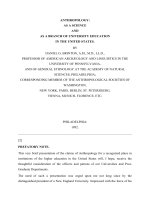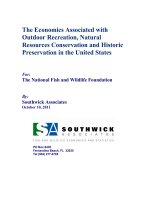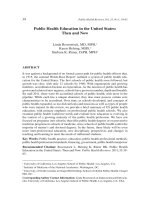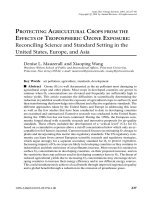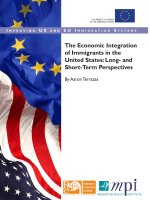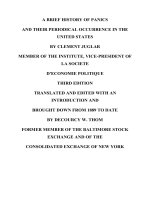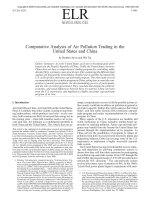Domestic Trends in the United States, China, and Iran - Implications for U.S. Navy Strategic Planning pdf
Bạn đang xem bản rút gọn của tài liệu. Xem và tải ngay bản đầy đủ của tài liệu tại đây (1.14 MB, 234 trang )
This document and trademark(s) contained herein are protected by law as indicated
in a notice appearing later in this work. This electronic representation of RAND
intellectual property is provided for non-commercial use only. Unauthorized
posting of RAND PDFs to a non-RAND Web site is prohibited. RAND PDFs are
protected under copyright law. Permission is required from RAND to reproduce,
or reuse in another form, any of our research documents for commercial use. For
information on reprint and linking permissions, please see RAND Permissions.
Limited Electronic Distribution Rights
Visit RAND at www.rand.org
Explore the RAND National Defense
Research Institute
View document details
For More Information
This PDF document was made available
from www.rand.org as a public service of
the RAND Corporation.
6
Jump down to document
THE ARTS
CHILD POLICY
CIVIL JUSTICE
EDUCATION
ENERGY AND ENVIRONMENT
HEALTH AND HEALTH CARE
INTERNATIONAL AFFAIRS
NATIONAL SECURITY
POPULATION AND AGING
PUBLIC SAFETY
SCIENCE AND TECHNOLOGY
SUBSTANCE ABUSE
TERRORISM AND
HOMELAND SECURITY
TRANSPORTATION AND
INFRASTRUCTURE
WORKFORCE AND WORKPLACE
The RAND Corporation is a nonprofit
research organization providing
objective analysis and effective
solutions that address the challenges
facing the public and private sectors
around the world.
Purchase this document
Browse Books & Publications
Make a charitable contribution
Support RAND
This product is part of the RAND Corporation monograph series.
RAND monographs present major research findings that address the
challenges facing the public and private sectors. All RAND mono-
graphs undergo rigorous peer review to ensure high standards for
research quality and objectivity.
Prepared for the United States Navy
Approved for public release; distribution unlimited
NATIONAL DEFENSE RESEARCH INSTITUTE
John Gordon IV, Robert W. Button, Karla J. Cunningham,
Toy I. Reid, Irv Blickstein, Peter A. Wilson, Andreas Goldthau
Implications for U.S. Navy
Strategic Planning
Domestic Trends
in the United States, China, and Iran
The RAND Corporation is a nonprofit research organization providing
objective analysis and effective solutions that address the challenges
facing the public and private sectors around the world. RAND’s
publications do not necessarily reflect the opinions of its research clients
and sponsors.
R
®
is a registered trademark.
© Copyright 2008 RAND Corporation
All rights reserved. No part of this book may be reproduced in any
form by any electronic or mechanical means (including photocopying,
recording, or information storage and retrieval) without permission in
writing from RAND.
Published 2008 by the RAND Corporation
1776 Main Street, P.O. Box 2138, Santa Monica, CA 90407-2138
1200 South Hayes Street, Arlington, VA 22202-5050
4570 Fifth Avenue, Suite 600, Pittsburgh, PA 15213-2665
RAND URL:
To order RAND documents or to obtain additional information, contact
Distribution Services: Telephone: (310) 451-7002;
Fax: (310) 451-6915; Email:
Library of Congress Cataloging-in-Publication Data
How domestic trends in the U.S., China, and Iran could influence U.S. Navy strategic
planning / John Gordon IV [et al.].
p. cm.
Includes bibliographical references.
ISBN 978-0-8330-4562-1 (pbk. : alk. paper)
1. United States. Navy—Planning. 2. Strategic planning—United States.
3. Social prediction—United States. 4. Economic forecasting—United States.
5. Social prediction—China. 6. Economic forecasting—China. 7. Social
prediction—Iran. 8. Economic forecasting—Iran. I. Gordon, John, 1956–
VA58.4.H69 2008
359'.030973—dc22
2008044846
Cover Photo Credits: AP Images/Greg Baker; AP/Vahid Salemi
Cover Design by Carol Earnest
The research described in this report was prepared for the U.S. Navy’s
Office of the Chief of Naval Operations, Assessment Division (N81).
The research was conducted in the RAND National Defense Research
Institute, a federally funded research and development center sponsored
by the Office of the Secretary of Defense, the Joint Staff, the Unified
Combatant Commands, the Department of the Navy, the Marine Corps,
the defense agencies, and the defense Intelligence Community under
Contract W74V8H-06-C-0002.
iii
Preface
is book examines the future of the United States, the People’s Repub-
lic of China, and Iran. Specifically, it reviews how important domes-
tic trends—such as changes in the economy, demographics, and the
environment—may influence the priorities of these three nations in
the future. is research is the second in a series of strategic studies the
RAND Corporation conducted for the U.S. Navy’s Office of the Chief
of Naval Operations, Assessment Division (N81). e initial research
was conducted in the summer and fall of 2006. Entitled “Evolving
Strategic Trends, Implications for the U.S. Navy,” that first study was
intended for a select Navy audience. It identified likely major global
strategic trends in the next decade and how they might influence Navy
planning. Although the present book focuses primarily on domes-
tic trends, it also explores how events in the so-called near abroad of
each nation may influence how the three principal nations view their
strategic situation. Based on the insights gained during their research,
the authors provide conclusions and recommendations that will be of
interest not only to the study’s sponsor, the U.S. Navy, but also to a
wider range of policymakers and academics in the United States and
elsewhere.
is research was sponsored by the U.S. Navy’s Office of the
Chief of Naval Operations, Assessment Division (N81), and conducted
within the International Security and Defense Policy Center (ISDP)
of the RAND National Defense Research Institute, a federally funded
research and development center sponsored by the Office of the Secre-
tary of Defense, the Joint Staff, the Unified Combatant Commands,
iv Domestic Trends in the United States, China, and Iran
the Department of the Navy, the Marine Corps, the defense agencies,
and the defense Intelligence Community.
For more information on RAND’s International Security and
Defense Policy Center, contact the Director, James Dobbins. He
can be reached by email at ; by phone at
703-413-1100, extension 5134; or by mail at the RAND Corpora-
tion, 1200 South Hayes Street, Arlington, Virginia 22202-5050. More
information about RAND is available at www.rand.org.
v
Contents
Preface iii
Figures
ix
Tables
xi
Summary
xiii
Acknowledgments
xxv
Abbreviations
xxvii
CHAPTER ONE
Introduction and Objectives 1
Introduction
1
Study Approach
1
Organization of is Monograph
4
CHAPTER TWO
Strategic Trends in the United States 5
Summary
5
Introduction
6
U.S. Demographic Trends
6
Gross Domestic Product
9
e Federal Budget
10
Federal Revenues
11
Federal Spending
11
Social Security
12
Medicare and Medicaid
13
Interest on the National Debt
15
Federal Spending
15
vi Domestic Trends in the United States, China, and Iran
Discretionary Spending 16
Nondefense Discretionary Spending
17
Natural Disasters
17
Energy
20
Defense Spending
24
Conclusions
26
CHAPTER THREE
e United States’ Near Abroad 29
e Current Situation
29
Future Trends and Possibilities in Northern South America
31
Future Trends and Possibilities in the Caribbean
32
An Overview of Future Trends in the Region
34
e Special Case of Mexico
35
CHAPTER FOUR
Strategic Trends in the People’s Republic of China 37
e Current Situation
37
China’s Energy Future
39
Consumption Pattern and Energy Mix
39
China’s Coal Industry
45
Macroeconomic Trends
46
GDP Forecasts
48
Obstacles to Future Growth
50
China: A High-Tech Economy?
56
Demographic Trends and Related Problems
59
Aging and Social Security
59
Gender Imbalance
64
Floating Population and Urbanization
64
Public Health
66
Environmental Degradation
69
Water Scarcity and Pollution
70
Desertification
74
Air Pollution
76
Enforcement
79
Supply Trends
79
Conclusion
80
Contents vii
CHAPTER FIVE
China’s Near Abroad 87
e Current Situation
87
Future Trends and Possibilities in the West
90
Future Trends and Possibilities in the South
91
Future Trends and Possibilities in the East and Northeast
92
Taiwan
92
North Korea
93
Japan
95
CHAPTER SIX
Strategic Trends in Iran 97
e Current Situation
97
Economic Trends
98
Rentierism
99
Unemployment and Underemployment
103
Demographic Pressures
105
Energy Production and Consumption Patterns
107
Nuclear Energy
109
Sociopolitical Trends
112
Environmental Trends
118
Conclusion
121
CHAPTER SEVEN
Iran’s Near Abroad 125
e Current Situation
125
Future Trends and Possibilities in Russian and Chinese
Support for Iran
127
Future Trends and Possibilities in Saudi Arabia and the Gulf
Cooperation Council States
128
Future Trends and Possibilities in Turkey and the Kurdish
Independence Movement
129
Future Trends and Possibilities in Israel, Lebanon,
Palestine, and Syria
130
Summary
131
viii Domestic Trends in the United States, China, and Iran
CHAPTER EIGHT
Japan’s Near Abroad 133
e Current Situation
133
Current State of U.S Japanese Relations
134
Japan’s Current Relations with Its Asian Neighbors
136
Future Trends and Possibilities
139
CHAPTER NINE
Russia’s Near Abroad 143
e Current Situation
143
Current Russian-European Relations
149
Current Sino-Russian Relations
151
Current Russian-Iranian Relations
152
Current Russian-Japanese Relations
154
Future Trends and Possibilities
155
CHAPTER TEN
Conclusions 159
Major Future Domestic and Near-Abroad Challenges
159
e United States
159
China
160
Iran
162
Common Challenges
163
Aging
163
Pollution
163
Energy
164
Implications
165
For the United States
165
For the U.S. Navy
166
Investment Implications for the U.S. Navy
168
Final oughts
170
APPENDIXES
A. Comparisons 171
B. China’s Coal Future
177
Bibliography
191
ix
Figures
2.1. Historical and Projected U.S. Birthrates 7
2.2. Long-Term U.S. Demographic Trends
8
2.3. Number of Workers per Social Security Beneficiary
9
2.4. GDP Growth Projection
10
2.5. Projected per Capita U.S. GDP
11
2.6. Historical and Near-Term Federal Spending as a
Percentage of GDP
12
2.7. U.S. Military Medical System Spending by Category
14
2.8. Federal Outlays by Category, 1950–2075
16
2.9. Cumulative Storm Damage
18
2.10. U.S. Oil Production, 1900–2005
21
2.11. Past and Projected Navy and Marine Corps
Investment Spending
24
2.12. Past and Projected Defense Spending
25
4.1. China’s Primary Energy Demand
40
4.2. China’s Projected Primary Energy Mix
42
4.3. China’s Oil Balance
43
4.4. China’s Oil Import Sources
44
4.5. China’s Coal Production Since 1970
46
4.6. Ratio of Working-Age Chinese to Elderly Chinese
61
6.1. RAND Projections of Iranian per Capita GDP
101
6.2. RAND Projections of Iranian GDP Growth
102
6.3. Iran’s Employment Crisis
104
6.4. Iran’s Total Fertility Rate
106
6.5. Iranian Population Distribution, 2005–2050
107
6.6. Iranian Natural Gas
109
6.7. Iranian Electricity
110
x Domestic Trends in the United States, China, and Iran
6.8. Iranian Oil Patterns 110
6.9. Iranian Freedom Ranking
115
6.10. e Evolution of Environmental Damage by Sector
119
6.11. Iranian Urbanization
120
B.1. China’s Coal Production Since 1970
180
B.2. Projections of China’s Cumulative Coal
Production from 2005
181
B.3. Historical British Coal Production
182
B.4. Projections of Time to Peak Coal Production in China
183
B.5. Global Coal Reserves and Production Rates
187
B.6. Possible Worldwide Coal Production
188
B.7. Coal Production in China Based on Current
Reserve Estimates
189
xi
Tables
9.1. Gross Domestic Product in 2006 144
A.1. Comparison of Major Trends
172
xiii
Summary
is monograph is the second in a series of strategic studies conducted
by the RAND Corporation for the U.S. Navy’s Office of the Chief
of Naval Operations, Assessment Division (N81). e initial research
was conducted in the summer and fall of 2006. Entitled “Evolving
Strategic Trends, Implications for the U.S. Navy,” that first study was
intended for a select Navy audience. It identified likely major global
strategic trends in the next decade and how they might influence Navy
planning. As a result of that study, N81 asked RAND to conduct a
follow-on effort that focused primarily on the domestic trends of the
United States, China, and Iran. e Navy wanted insights on how
these important trends could influence U.S. security decisions in gen-
eral and the Navy’s allocation of resources in particular.
Study Approach
Whereas the first strategic-trends study was primarily concerned with
security-related issues around the world that could influence U.S. mili-
tary planning, this monograph discusses internal, nonmilitary trends
in the United States, the People’s Republic of China (PRC), and Iran.
e Navy is interested in these countries’ likely key “resource driv-
ers” from now through roughly 2020–2025.
1
Accordingly, we exam-
ined important domestic trends in each country—in demographics,
1
e period covered by data related to future economic and demographic projections for
the United States, China, and Iran varied. In some cases, projections through 2020 were
xiv Domestic Trends in the United States, China, and Iran
economics, energy consumption, the environment, and education—to
gain an understanding of each nation’s likely “big issues.” Depending
on how much of a challenge those issues become in the United States,
China, and Iran, the Navy may have to divert considerable resources to
address emerging problems.
Although our primary focus is on domestic trends in each nation,
this monograph also examines each nation’s so-called near abroad. We
conducted this research to determine how much of a challenge each of
the three nations will experience in their own immediate “neighbor-
hoods.” In the case of the United States, this neighborhood includes
the Caribbean, Central America, Mexico, and northern South Amer-
ica. We divided China’s near abroad into three general regions: the east-
northeast (where most of China’s near-term security challenges lie), the
south and southeast, and the west. In Iran’s near abroad, the Middle
East, we examine how the current turbulent situation might influence
Iran’s strategic planning and resource-allocation decisions.
N81 also asked that we examine the near abroads of Russia and
Japan. is was considered important due to each country’s relationship
with the three primary countries. For example, China closely watches
how Japan’s security policy is evolving, and also has a very important
relationship with Russia. Our assessments of Russia and Japan do not
include the more-detailed research on domestic trends we conducted
for the three primary nations.
The United States
e United States will remain the richest nation in the world during
the period covered in this monograph. Today, the U.S. economy is
roughly $13 trillion. at total is projected to rise to roughly $30 tril-
lion by 2020. us, most of the U.S. population will continue to enjoy
rising standards of living.
available; in other cases, projections extended out through 2025. erefore, this study’s “out
years,” the far-term planning horizon, are 2020–2025.
Summary xv
e main challenge that the United States will experience from
now until 2025 (and beyond) will arise from the increasing numbers of
elderly Americans. Today, there are approximately three active workers
for each recipient of Social Security. at ratio will drop to two work-
ers per retiree by about 2015. Elderly people require considerably more
health care and other social services compared to younger portions of
the population. Social Security expenditures will increase during this
period, but the main increase will occur in Medicare and Medicaid,
the federal government’s health programs for those over the age of 65.
Although the U.S. economy is projected to expand annually from now
until 2025, social spending for America’s growing numbers of elderly
citizens will consume an ever-increasing portion of the federal budget
and the overall economy. is increase will constrain other spending
programs, including national defense. After 2015, given this projected
need for an increase in social spending for the elderly, and absent a
clearly perceived threat comparable to that posed by the Soviet Union
during the Cold War, it is likely that senior U.S. policymakers will be
less willing—and possibly less able—to devote as much of the nation’s
wealth to defense as they did during the Cold War or even today’s
global war on terrorism.
Despite the coming challenge of increased social spending as
“baby boomers” enter their retirement years, the United States is a rich
nation that will be able to provide for increasing numbers of elderly cit-
izens (if it chooses to do so). In that regard, “the United States became
rich before it became old.” We will see that a different situation prevails
in China.
e United States has also been fortunate that it has not had
to devote considerable military resources to its near abroad since the
Spanish-American War of 1898. Although there have been occasional
periods of tension (such as the Cuban Missile Crisis of the early 1960s),
the United States has generally been able to keep its military focused in
other, more-distant regions. Whether that favorable situation will con-
tinue depends in large part on (1) whether there is a sustained increase
in the popularity of anti-American, leftist regimes in Latin American
(such as Hugo Chavez’s Venezuela) and (2) events in post-Castro Cuba,
xvi Domestic Trends in the United States, China, and Iran
where a chaotic situation could result in some form of protracted U.S.
military intervention.
China
e PRC has enjoyed 30 years of explosive economic growth. is
economic growth has enabled China to undertake a significant mil-
itary modernization program for the past several years. In the near
to medium term (i.e., through roughly 2020), the growth of China’s
economy will continue to enable the Chinese to expand the nation’s
military capabilities. Projections of China’s gross domestic prod-
uct (GDP) in 2020 vary considerably, ranging from $12 trillion to
$15 trillion. We argue that mounting internal pressures will limit Chi-
na’s ability to expand militarily into the out years.
China has entered into a Faustian bargain, however. In exchange
for wealth and military power, China has sacrificed its energy (coal)
future, embarked on a program of unsustainable economic growth,
sacrificed the well-being of its elderly, and allowed extensive environ-
mental damage to occur. ese problems are intertwined. e depletion
of coal reserves, for example, will encourage the Chinese to use lignite
coal, a fuel source that produces less energy and more pollution than
higher grades of coal. Increased use of lignite would increase pollution
and thus lead to increased acid rain and environmental degradation.
Until recently, China has been self-sufficient in coal. It now uses
coal for about 70 percent of its electrical power. Coal consumption in
China has roughly kept pace with China’s economic growth, increas-
ing by 80 percent since 2000 and 2,000 percent since China’s last pub-
licly released coal survey in 1992. Several recent credible studies sug-
gest that China’s coal production will peak sometime between 2015
and 2025, with coal production levels between 2030 and 2040 falling
below current levels unless significant new reserves are found. Even
if new reserves are located, China could face significant challenges in
extraction, coal quality, and infrastructure. In addition to significantly
increasing its oil and natural gas imports, China is transitioning from
a net exporter of coal to a net importer.
Summary xvii
Note, however, that some of the data underlying these figures are
uncertain. For example, coal-reserve estimates could be low, and coal
is still being discovered in China.
2
Furthermore, growing coal short-
ages could encourage both exploration for additional sources of coal
and greater coal production efficiency. Some coal geologists argue that
China has a 2,500-year history of organized coal production, making
further major coal finds unlikely. Coal engineers point to problems in
increasing the efficiency of mines that have not achieved acceptable
safety levels. Clearly, exponentially increased consumption rates have
correspondingly advanced the date of China’s coal peak. What appears
certain is that as the years go by, China will have to import a larger
amount of coal to meet its requirements. is greater dependence on
foreign coal could affect international coal prices. (However, because
coal is more globally plentiful than oil, increased Chinese coal imports
are not likely to affect coal prices.) Greater dependence will probably
result in increasing Chinese ties with the nations from which it imports
coal (e.g., Australia).
Until recently, China was self-sufficient in oil; in fact, China was
actually an oil exporter until 1993. Oil production in China has not
yet peaked, but China’s demand for oil under a burgeoning economy
has outstripped production. China’s urbanization, together with the
increased affordability of automobiles, has accelerated and will continue
to accelerate China’s oil demand. As a newcomer to the international
oil market, China first turned to lesser producers (such as Oman) and
sought exclusive drilling rights as a means to secure oil supplies. More
recently, China has turned to Africa and Iran for oil. Perhaps deliber-
ately, China has, through its choice of oil suppliers, avoided competi-
tion or confrontation with the United States in the international oil
market. Current trajectories of oil consumption suggest, however, that
this pattern will break as China turns to the Greater Middle East for
oil. Competition for access to affordable energy sources could become
a source of friction in Sino-U.S. relations.
2
Historically, however, China’s coal-reserve estimation technology has significantly over-
estimated coal reserves elsewhere in the world.
xviii Domestic Trends in the United States, China, and Iran
China’s economy has consistently experienced the world’s highest
growth rate since the early 1980s, posting an average growth of 10 per-
cent, according to official figures. Although this growth is remark-
able, it is not unprecedented. Other Asian economies, such as those of
Taiwan, South Korea, and Japan, demonstrated similarly strong growth
at the peak of their development trajectories; most of these economies
then experienced subsequent slowdowns to more-sustainable growth
levels. Meanwhile, the sheer scale of China’s internal needs is daunting,
and the gap between China and the most-developed nations is clear.
For example, China’s 2005 GDP per capita was roughly $1,700, a level
comparable to that of the United States in 1850.
China’s economic progress is complicated by the unique chal-
lenges that the country faces as the world’s most populous nation. It is
also complicated by the fact that China is simultaneously developing
and transitioning its economy from a closed, communist command
system to a market-driven, open system. Factors that once contributed
to China’s past growth—including greater openness to trade, improved
technology, and a large, youthful labor pool—will contribute less to
China’s economic growth in the future. Continued reform will require
the Chinese Communist Party (CCP) to cede more control to the pri-
vate sector, thereby weakening the CCP’s role in the economy. e
CCP has refused to cede control in some major areas, such as coal pro-
duction, thereby creating economic distortions throughout the econ-
omy. Knowing that deeper economic reforms will entail political risk,
it is not clear how much farther the CCP will be willing to go in eco-
nomic reforms. Furthermore, the following existing structural impedi-
ments and habitual problems are expected to weaken China’s future
economic growth:
e dysfunctional banking system supports approximately t
150,000 unprofitable state-owned enterprises that suck resources
from enterprises that may be more efficient and profitable.
China is overly dependent on exports, overinvestment, and under-t
valued currency for growth.
Inadequate educational systems produce unqualified graduates.t
Summary xix
China’s poor protection of intellectual property rights discourages t
innovation.
China’s once-youthful labor force is aging, and the declining
number of active workers will become an economic liability. More gen-
erally, China’s aging population will present major challenges in the
medium to far term (i.e., from 2015 to roughly 2025). China’s baby
boomers were born in the 1960s, and therefore its working-age popula-
tion will begin to shrink after 2015. In 2034, in some regions of China,
dependents will outnumber active workers.
In transitioning from a command-driven economy to a free-
market economy, China has failed to establish a well-funded social
security system. Over 300 million Chinese agricultural workers have no
social security, and urban workers’ social security accounts are under-
funded by more than $1 trillion. Today, there are approximately seven
active workers for every retiree in China. By 2020, that ratio will drop
to only two workers per retiree. Meanwhile, and in spite of the fact that
the Chinese economy will continue to grow, China’s per capita GDP
increases will still leave the nation rather poor by the standards of the
industrial world. Compared to the United States, then, it can be said
that “China will get old before it gets rich.”
By 2025, more than 300 million Chinese citizens will be age 66
or older. is will place a great strain on the nation’s social services,
which today are considerably behind those of the United States, Japan,
and most of Europe. Chinese workers have limited access to health
insurance, and preventative health care for children is lagging. More
importantly, China’s medical system is wholly unprepared to serve its
aging population. e strain that an increased number of elderly Chi-
nese will place on China’s resources after 2020 will almost certainly
affect on the nation’s ability to continue a major military buildup.
China has serious and growing environmental problems. Water is
scarce and polluted. Two-thirds of China’s cities now experience signif-
icant water shortages. Over half of all urban waste water is untreated,
and over three-quarters of river water in urban areas is unsuitable
for drinking or fishing. Many of China’s rivers are polluted to levels
incomprehensible to most Westerners; these waters are deemed too pol-
xx Domestic Trends in the United States, China, and Iran
luted for any beneficial use, even industrial use. Economic growth and
the degradation of China’s rivers have increased demands for ground-
water. China’s deserts are spreading: More than a quarter of China’s
land is now desert. Groundwater in some regions of China is expected
to be exhausted within 15 years, leaving residents without usable water.
Economic growth will be retarded by a growing “bow wave” of envi-
ronmental damage (which is estimated to be slowing China’s current
GDP growth by about 5 percent).
e rapid industrialization of many of the country’s urban areas
has entailed high levels of air pollution. ese levels are much higher
than would be tolerated in the United States or most of Europe. As
observed above, China has dramatically increased the use of coal for
electrical power to meet its rapidly growing energy needs; it plans to
open scores of new coal-fired power plants in the coming years. Chi-
na’s coal is relatively dirty and the country has not invested adequately
in coal-cleaning facilities. China’s approximately 400,000 coal-fired
industrial facilities nationwide produce millions of tons of ash and
sulfur dioxide, a source of acid rain.
By 2020, China will enter a “perfect storm” of economic, envi-
ronmental, and social problems largely of its own making. In the next
10–15 years, while trying to grow and transform its economy, China
will confront the intertwined problems of premature depletion of its
energy resources, faltering economic growth, inadequate provisions for
its aging population, and the need to remediate an extensively damaged
environment. China’s ability to modernize and expand its military at
the same time will be constrained by these domestic challenges.
e PRC’s current relations with nations in its near abroad vary
considerably. Chinese relations with countries to the south (e.g., Viet-
nam and India) are better than at any point in the past three decades.
Mutual economic interest has contributed greatly to this improved sit-
uation. Of significant importance is China’s increasing westward stra-
tegic orientation into Central Asia and the Middle East. In the near to
medium term (i.e., from today through approximately 2020), China
will increase its involvement in the former Soviet republics of Cen-
tral Asia and further expand its growing presence in the Middle East,
including Iran. China’s rapidly expanding energy needs guarantee that
Summary xxi
this trend will continue for the foreseeable future. Areas east and north-
east of China pose the greatest threat to China in the near to medium
term. How the situation with Taiwan evolves in the next decade will
have great bearing on Sino-Japanese and Sino-U.S. relations. In addi-
tion to the still-uncertain situation with Taiwan, there is potential for a
crisis in northeast Asia, where the Stalinist regime of North Korea has
acquired nuclear weapons. e Japanese are watching developments
in Taiwan and the Korean Peninsula with considerable interest, and
a significant change in Japan’s security policy is possible. e PRC is
likely to take seriously any Japanese actions that may threaten Chinese
interests.
Iran
Iran is rich in oil and natural gas. It also has one of the best primary
and secondary education systems in the Muslim world. It therefore has
the means to develop a healthy economy. However, major structural
problems in its economy and political system are causing the country
to perform far below its theoretical potential.
Iran’s government has been largely ineffective in harnessing the
country’s energy potential. e country’s high unemployment and
underemployment rates have resulted in rising numbers of jobless
youths. e lack of employment opportunities has contributed to the
country’s ongoing “brain drain,” and tens of thousands of its middle
and educated classes depart the nation each year in search of better
opportunities elsewhere. Over the next 20 years, Iran’s per capita
income will grow only modestly.
Iran’s inability to adequately exploit its economic potential means
that Iran will lack the ability to create a military force that can dom-
inate the entire Middle East. However, as long as current ideology
continues to dominate Iran’s government, Iran will remain generally
opposed to U.S. interests in the region. More likely than any direct
confrontation with the United States and European nations is the pos-
sibility that Iran will attempt to undermine the U.S. position in the
region through more-clandestine means (such as support to terrorist
xxii Domestic Trends in the United States, China, and Iran
groups and proxies, including Hezbollah). Additionally, Iran will seek
out a major ally in the form of Russia, China, or both. If either nation
strongly backs Iran, Iran will be more likely to become emboldened in
its willingness to challenge U.S. interests in the region. Iran’s pursuit of
nuclear weapons, and its possible success in that regard, is another issue
that could destabilize the entire region.
If Iran’s economy continues to underperform, the role of the Ira-
nian military could increase. is could lead to a situation roughly
similar to the role of the armed forces in Pakistan or Turkey, which
dominate many aspects of government. In the case of Iran, an impor-
tant issue would be the relative strength of the Revolutionary Guard
and the conventional branches of the military.
Japan
Japan will remain the richest nation in Asia through the out years.
3
However, the country’s population will age considerably. Unlike the
United States, but like China, Japan admits few immigrants. With low
immigration levels and a very low birthrate, Japan’s population levels
are bound to decline in the coming decades. is demographic trend
will force changes in social spending in Japan, as will be the case in the
United States and China.
Of primary concern for this study were Japan’s relations with its
near abroad. In that regard, Japan has three major strategic options:
strengthening its ties with the United States—this is Japan’s pres-t
ent course of action
reaching an accommodation with the PRC—a strategy that t
acknowledges that U.S. power in Asia is waning, while China’s
is rising
adopting a more independent course of action in terms of foreign t
and security policy—this option may ultimately entail acquiring
a nuclear-deterrent capability.
3
As previously noted, RAND examined Japan’s near-abroad issues only.
Summary xxiii
Japan’s choice will be of very great interest to the United States and
China.
Russia
Following a near-disastrous decade after the collapse of the Soviet
Union, Russian strength is starting to rise again.
4
Russia is currently
benefiting from the rise in oil and natural gas prices, which has facili-
tated renewed modernization efforts by the Russian military. Mean-
while, Russia is taking an increasingly assertive approach to its own
near abroad.
Of vital interest to the United States is how Russian relations
with Iran and China evolve in the coming decade. Iran clearly wants
support from Russia, China, or both. Meanwhile, the evolving Sino-
Russian relationship could develop in a way that opposes U.S. inter-
ests. Russia is also becoming increasingly assertive with former Soviet
republics, especially those in Central Asia. is might lead to tension
with China, since the PRC is leaning westward due to its growing
energy needs.
Implications for the U.S. Navy
Although the United States will remain the world’s richest nation for
the next 20–30 years, the steady aging of its population will create major
shifts in federal spending in the future. In the absence of a clearly per-
ceived threat comparable to the Cold War–era Soviet Union, spending
will gradually shift away from defense and toward the increased social
services needed to support an older population.
Meanwhile, U.S. dependence on foreign energy sources will
continue to grow. us, the Navy will be required to continuously
maintain powerful forces in the Middle East and the Western Pacific.
4
As previously noted, RAND examined Russia’s near-abroad issues only.
